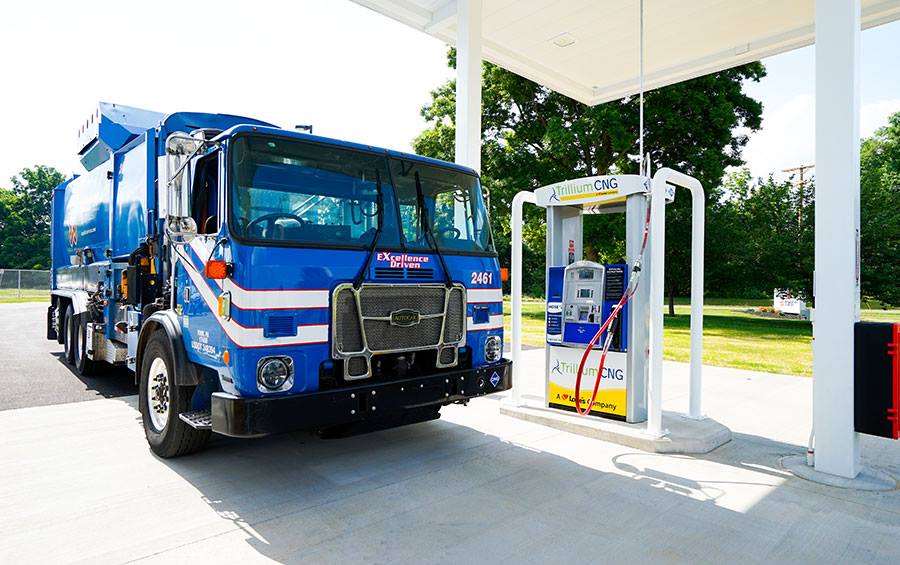In partnership with: Trillium

More and more heavy-duty fleets are turning to natural gas because of its ability to reduce costs and meet sustainability goals. Over the last decade, fleets of all types, sizes and duty-cycles have experienced benefits when switching to natural gas, but there are certain operating circumstances that have led to higher returns on investments. Based on real-world fleet experiences, a sweet spot for natural gas trucks has emerged, along with key best practices to ensure success with natural gas vehicles (NGVs).
The Magic is in the Miles Driven
Operating NGVs in high mileage applications has proven to be key for fleets to see a reduction in costs compared to diesel counterparts. As discussed at an ACT Fleet Forum meeting in November of 2019—which brought together 15 leading fleets and a handful of technology partners to discuss experiences with alternative fuels—fleet participants that have run their NGVs 80,000-120,000 miles annually found their investments really begin to pay off around the five-year mark.
Some fleet operators have reported they have run their NGVs for over 1 million miles and expect to continue running them for another million miles, proving that NGVs have the power, performance and reliability required to meet rigorous daily operations.
Typically, diesel trucks see a substantial increase in maintenance costs around the five- to six-year mark. Whereas natural gas trucks continue to experience low maintenance needs. To meet emission reduction regulations, diesel trucks require complex exhaust and filtration systems that need an increasing amount of maintenance the longer the vehicles run. Because natural gas is a cleaner fuel, NGVs do not require diesel particulate filters (DPF), DPF regeneration or waste, selective catalytic reduction (SCR) or diesel emission fluid (DEF). This makes NGVs much simpler and less expensive to maintain.
Additionally, fleets can make up costs by cutting downtime associated with diesel trucks. For example, at the ACT Fleet Forum meeting, one fleet reported $100,000 in avoided towing bills by using NGVs because diesel trucks are susceptible to breakdowns on the road from clogged aftertreatment systems.
As emission reduction regulations get stricter, diesel trucks will need more complex modifications to meet those standards, leading to even more maintenance costs. Whereas heavy-duty NGVs have already reached an emissions profile that is 90% cleaner than today’s emission standards.
Cost-Effective Emission Reductions
With a growing focus on climate-altering greenhouse gas (GHG) emissions globally and the impacts of poor air quality locally, the transportation sector—predominately made up of heavy-duty diesel trucks—has become one of the largest sources of emissions. Tackling transportation-related emissions is critical to meet climate protection and air quality goals. However, with finite resources, investments in new technologies and fuels must provide cost-effective emission reductions.
In a recent article, the California Natural Gas Vehicle Partnership documented that natural gas trucks can deliver more emission reductions when compared to battery electric trucks due to lower vehicle costs. Because they are more affordable, NGVs can be deployed in larger numbers with finite resources, yielding greater emission benefits.
Heavy-duty NGVs are commercially available today and sold by 10 major truck manufacturers—including Freightliner, Volvo, Kenworth, Mack, Peterbilt and others. Whereas battery electric trucks have not reached commercial maturity and therefore have long production and delivery timelines.
Not only do NGVs offer cost-effective emission reductions while meeting the power and performance requirements of rigorous daily fleet operations, there is a robust and growing network of natural gas fueling stations across the U.S. providing easy access to low emission fuel.
Stability and Reliability Fuels Natural Gas Savings
Natural gas is a domestically produced, price-stable and readily abundant fuel option, making it easier for fleets to plan for fuel costs over the long term. The U.S. is the number one producer of natural gas in the world, with more than a 90-year supply. Compared to diesel, the price of natural gas at the pump is not subject to volatile geopolitical factors.
As discussed in Trillium’s previous article, “CNG Provides Fleets Certainty Through Global Market Instability,” the national average price for compressed natural gas (CNG) has hovered around $2 per gasoline gallon equivalent (GGE) while diesel prices have varied by almost the same amount. The lower price differential of CNG is expected to continue over the next several decades, meanwhile the price of oil will continue to see dramatic price fluctuations due to regulations, disruptions in fuel production and global trade tensions.
Fleets already running NGVs in their operations can confidently scale their NGV fleet knowing fuel costs will be stable and predictable. For fleets that have yet to give NGVs a try, there is no better time than the present even with oil prices at historic lows. Fleets that do not invest in alternative fuel options now, will feel the effects when the price of oil inevitably goes back up.
Given the proven durability in high mileage operations, cost-effective emission reductions, widespread commercial availability of the vehicle technology and price-stable fuel, the deployment of NGVs can provide fleet operators increasing returns on their investments.
To learn more about how Trillium works with fleets to support the deployment of NGVs, visit www.trilliumcng.com or contact Lisa Swedler at lisa.swedler@trilliumcng.com.


